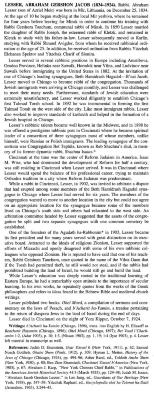Biography of Rabbi Avrahom Gershon Lesser from Orthodox Judaism in America: A Biographical Dictionary and Sourcebook
1996
caption:
LESSER, ABRAHAM GERSHON JACOB (1834 – 1924). Rabbi. Abraham Lesser (son of Azriel Meir) was born in Mir, Lithuania, on December 25, 1834. At the age of 10 he began studying at the local Mir yeshiva, where he remained for four years before leaving for Minsk in order to continue his training with Rabbi Gershom Tanchum, communal rabbi of Minsk. In 1850 Lesser married the daughter of Rabbi Joseph, the esteemed rabbi of Kletzk, and remained in Kletzk to study with his father-in-law. Lesser subsequently moved to Karlin, studying with Rabbi Shmuel Avigdor, from whome he received rabbinical ordination at the age of 25. In addition, he received ordination from Rabbis Yitzchak Elchanan Spektor and Yitzchak Charif of Slonim.
Lesser served in several rabbinic positions in Europe including Amstibova, Grondno Province, Helinka near Suwalk, Horodok near Vilna, and Ludvinov near Suwalk before immigrating to the United States in 1882. At the invitation of one of Chicago’s leading synagogues, Beth Hamidrash Hagadol – B’nai Jacob, Lesser moved to Chicago to become rabbi of the congregation. Thousands of Jewish immigrants were arriving in Chicago monthly, and Lesser was challenged to meet their many needs. Furthermore, standards of Jewish education were extremely unsatisfactory, and Lesser worked diligently to establish Chicago’s first Talmud Torah school. In 1892 he was instrumental in forming the first Talmud Torah on the west side of the city. Like most immigrant rabbis, Lesser also worked to improve standards of kashruth and helped in the formation of a Jewish hospital in Chicago.
Lesser’s rabbinic talents became well known in the Midwest, and in 1898 he was offered a prestigious rabbinic post in Cincinnati where he became spiritual leader of a consortium of three synagogues, most of whose members, unlike himself, were Russian or Polish immigrants. The leading synagogue of the consortium was Congregation Bet Tephila, known as Reb Shachna’s shul, in memory of its former dynamic rabbi, Shachna Isaacs.
Cincinnati at the time was the center of Reform Judaism in America. Isaac M. Wise, who had dominated the development of Reform for half a century, was still residing in Cincinnati when Lesser arrived. It was in Cincinnati where Lesser would spend the balance of his professional career, trying to maintain Orthodox tradition in a city where Reform Judaism was predominant.
While a rabbi in Cincinnati, Lesser, in 1902, was invited to arbitrate a dispute that had erupted among some members of Beth Hamidrash Hagadol synagogue in Chicago where Lesser had served for six years. The members of the congregation wanted to move to another location in the city but could not agree on an appropriate location for the synagogue because some of the members lived on Chicago’s south side and others had relocated to the west side. An arbitration committee headed by Lesser suggested that the assets of the congregation be split and two separate synagogues with one common cemetery be established.
One of the founders of the Agudath ha-Rabbonim* in 1903, Lesser became its first president and for many years served with great distinction on its executive board. Attracted to the ideals of religious Zionism, Lesser supported the efforts of Mizrachi and openly disagreed with some of his own rabbinic colleagues who opposed Zionism. He is reputed to have said that one of his teachers, Rabbi Gershom Tanchum, once quoted in the name of the Vilna Gaon that if the Torah had permitted theft, he still would not steal, and if the rabbis had prohibited building the land of Israel, he would still go and build the land.
While Lesser’s education was deeply rooted in the traditional learning of Eastern Europe, he had remarkably open attitude to the importance of secular learning. In his own works, he repeatedly quotes from the works of the Greek philosophers and refers to ideas found in the Hebrew Bible and medieval church writings.
Lesser published two books: Ohel Moed, a compilation of sermons and commentary on the laws of the Pesach, and b’Acharit ha-Yamim, a treatise pertaining to the return of diaspora Jews to the land of Israel during the end of days.
Lesser died in Cincinnati on the night of Yom Kippur, October 7, 1924.
Identifer: CJF-2015007
Medium
Book



Leave a Comment